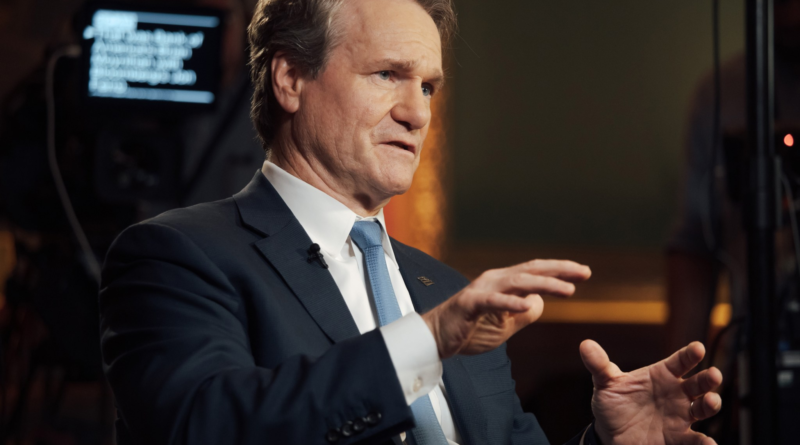Bank of America CEO Brian Moynihan says U.S. economy is the envy of the world—but could lose its power due to national debt
Uncle Sam’s national debt has tipped over the $35.7 trillion mark, meaning the burden for each person in America is now more than $105,000.
Moynihan, like his Wall Street peer Jamie Dimon and Fed Chairman Jerome Powell, is pushing politicians to prioritize plans for bringing the country’s debt-to-GDP back into line.
Unfortunately for Moynihan, the potential new incumbents to the White House are paying little heed to their warnings.
In fact, plans under both Donald Trump and Kamala Harris would increase America’s public debt by trillions.
Moynihan believes America is headed for a rude awakening if it doesn’t balance its spending with its growth. If the problem isn’t addressed, America could lose its place as the economic “gold standard.”
“If you go back the last 10, 12 years, there’s been a constant worry about the debt getting too far ahead,” Moynihan told Fox News.
“Then we had COVID, which required a lot of money being spent by the government to win the war on the virus and keep the economy from going really south and really having a deep recession.
“The government—the prior administration and the current administration—all did a good job. That’s gone now. Now we’ve gotta say, like every war you’ve fought: ‘How do you pay the bills after?’”
According to the Committee for a Responsible Federal Budget, the net increase in debt under President Donald Trump was $8.4 trillion: $4.8 trillion in non-COVID-related borrowing and $3.6 trillion for the CARES Act and COVID relief.
President Joe Biden increased national debt by $4.3 trillion: $2.2 trillion in non-COVID borrowing and $2.1 trillion for the American Rescue Plan.
How does the U.S. rebalance its debt?
Economists aren’t worried about the American government borrowing; in fact, it’s necessary to maintain the nation’s crucial bond market.
What they are worried about is the country’s debt-to-GDP ratio.
If this ratio is out of balance, it signals that the U.S. economy is not generating enough growth to service existing debt or take out more loans needed for fiscal policies in the future.
A March report from the Congressional Budget Office (CBO) estimates that by 2054, public debt will represent 166% of GDP, reaching $141.1 trillion.
Moynihan said some tough decisions lie ahead: “It’s going to take a combination of extreme discipline on all sides … There have always been proposals, but it’s time we have to do it.
“It doesn’t take a massive move one way or the other way,” Moynihan added. “It just takes a ‘Look, at the end of the day we spend more money than we bring in. We gotta narrow that gap.’
“Yet we’ve got to spend on defense, we’ve got to spend on social services programs, we got to invest in infrastructure. There’s all kinds of things that have got to go on, but at the end of the day, you’ve got to start to get your eyes and stomach aligned.”
To bring the debt-GDP balance into line, policymakers have two options: cutting spending or increasing GDP.
“You can do it different ways. You can do it through growth, you could do it through expense discipline, you can do it through raising taxes, you can do it through lowering taxes to create more investment,” Moynihan added. “But I’m telling you, around the world, this economy is the envy of everyone, and if we don’t manage the debt well, it may not be so envious in the future.”
When to tackle the problem
Some experts believe that America’s national debt doesn’t pose a problem because recent spending has been aimed at increasing productivity.
“Public debt is justified if it is invested in productivity-enhancing measures that will ensure the economy generates growth that’s required to finance that debt,” Columbia University professor Brett House told Fortune in April.
He added that while a debt-to-GDP ratio of over 100% would be a problem for most countries, “the United States is not most countries.”
Professor House added America “issues all of its debt in U.S. dollars, and consistently, when we see the world in political or financial crisis, money flows into U.S. Treasuries and the bond market as a safe store of value. Because the U.S. issues all of its debt in U.S. dollars it always has the possibility of finding additional buyers for its debt.”
A host of experts disagree with this take, saying the market will one day question whether America can pay its debt.
Moynihan clearly believes Uncle Sam’s debt will become a problem if left unchecked, but didn’t set the countdown in the short term: “It’s not an issue to handle in the first week of a new administration or an old administration continuing—it’s the question of having the discipline across time.”




